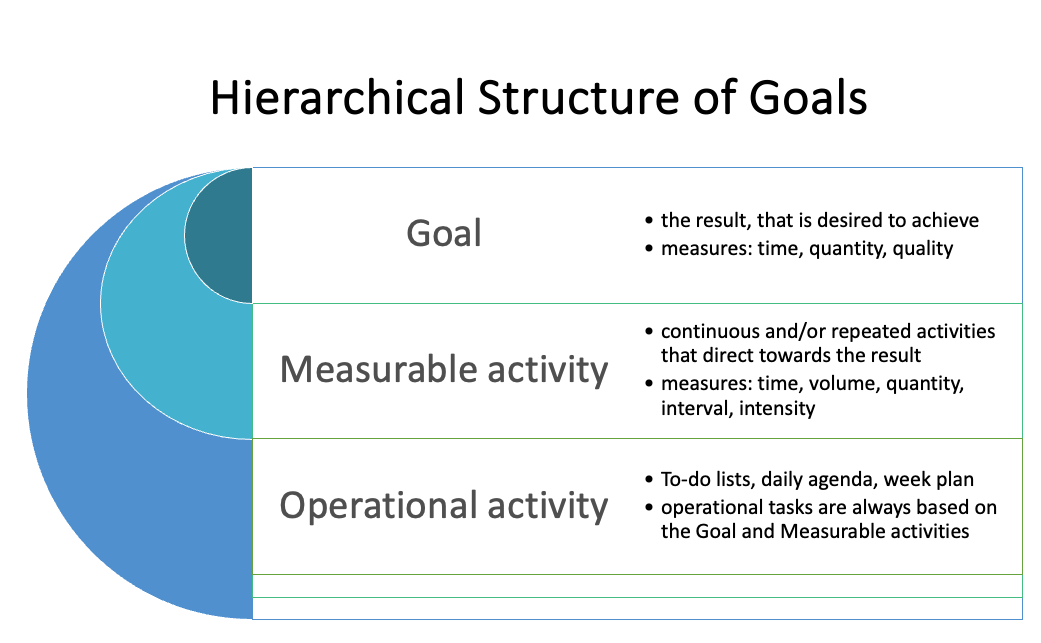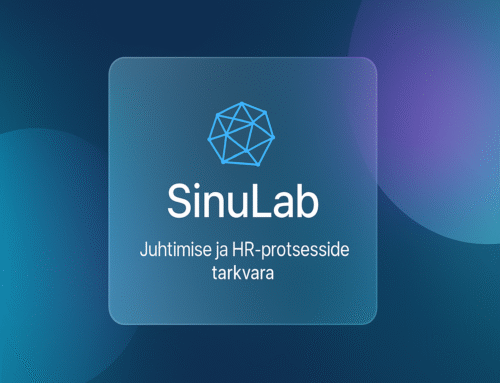The anatomy of professional goals
The role of a leader in setting and achieving high-quality goals is crucial. Primarily, a leader’s role is to act as a discussion partner, questioner, challenger, and confidence booster for their team members. Leaders often assume that employees know how to set goals and understand how to achieve them. Generally, this is not the case, and Employees need guidance, practice, and feedback.
The first important principle is that all of an Employee’s work-related goals should derive from the department’s, function’s, or organization’s objectives. The most important checkpoint in setting and achieving work-related goals is the question: How do my goals and activities help achieve the organization’s objectives?
Each work-related goal needs to be handled separately and attentively. To achieve a goal, the path to the result must also be thought through. Usually, the goal itself is a “formulated measurable expectation,” which includes various activities, metrics, and daily tasks. Thinking through the goal and formulating activities is precisely where a leader can guide and support the employee.
Problems arise when leaders expect daily results from employees, but the goals, activities, and metrics have not been thoroughly considered. This usually leads to a situation where daily fires are put out, and urgent ongoing activities are performed, but by the end of the day, the results are not what they should be.
The diagram illustrates the levels of objectives, where each preceding level provides the primary input for the next. The very first level, or the “GOAL,” acts as the core from which all subsequent levels derive. The Goal is a formulated as an end result that one aims to achieve. This, in turn, can be divided into several sub-activities necessary to achieve the outcome. The purpose of these sub-activities is to define how often, to what extent, and at what interval the activities will be carried out. The operational level involves the daily planning and execution of activities and tasks. The purpose of the operational level is to plan one’s day or week as efficiently as possible. More details and examples are provided below.
What can Manager do?
Let’s go through the step-by-step example of how to professionally carry this out.
1.Defining the Goal: What Should the Expected Outcome Be?
- Start by agreeing on the period within which you will be working towards the goals. This could be an annual period or shorter.
- Task: The Employee should write down the expected outcomes for the period, their descriptions, and metrics.
- Discuss together and help the employee define what they want to achieve during the year, ensuring these goals align with the organization’s strategic objectives.
- Analyze the goal level together to ensure it contains the necessary indicators to later assess if the outcome has been achieved. The metric can be both quantitative and qualitative. It is always possible to add a numerical metric to a qualitative one. Some examples are below.
Example 1: Acquire new competence – project management.
- Metric: Able to independently manage high-budget projects, including assembling the necessary team and budget. Shadowed at least 2 projects as a project manager.
- Deadline: 1 year to acquire competence.
- Importance: Taking on new career challenges, ensuring internal project management succession, meeting the needs arising from the growth of new large client projects.
Example 2: Bring in new clients.
- Metric: At least 10 new clients whose purchasing profile consists of at least 4 products and who place at least 2 orders during the year.
- Deadline: Within a year.
- Importance: Expanding market share, broadening the product portfolio, long-term client relationships.
2.Measurable Activities That Help Achieve the Set Goal
- Task: The employee describes all the steps and activities necessary to reach the goal.
- Each activity should have a description, required volume/quantity, implementation interval, and deadline or timeframe.
Example 1: Project Management Competencies
- Activities: 1) Attend three training sessions, 2) Obtain project manager certification, 3) Meet with a project manager mentor every 2 weeks, 4) Analyze the budgets and fulfillment of 3 previous projects and discuss with project managers.
- Deadlines: Dates for attending training, certification exam deadline, mentoring sessions scheduled in the calendar, two budget analyses per quarter.
Example 2: New Clients
- Activities: 1) Mapping potential clients and market analysis, 2) Identifying the right contact persons, first contact, 3) Maintaining regular contact with potential clients and sending proposals, marketing activities, 4) Organizing a new client seminar day.
- Deadlines: Mapping potential in January, first contact January-March, marketing activities with the client 2x a month, seminar day in September.
3.Operational Action Plan and Implementation
- Task: The employee prepares a weekly plan and activities for each day, defining three to five main tasks related to their goals.
- Encourage the employee to initially analyze each workday and productivity – were the plan and execution in sync?
- Occasionally conduct joint weekly reviews and assess where the time was mainly spent and whether the tasks were completed.
- Discuss and assess whether planning has proven effective and what the employee has learned from it.
- Determine the suitable work pace for the employee to avoid the risk of excessive intensity and burnout.
- Discuss emerging obstacles and what support the employee needs from the manager.
Example 1: Project Management Competencies
- Tasks: Plan weekly activities, such as working with study materials and scheduling mentor meetings. Some activities also require preparation.
Example 2: New Clients
- Tasks: Schedule two hours on two days for working with the client database, meetings with the marketing department to agree on the potential client strategy, about 1.5 hours on one day.
Repetitive tasks can be scheduled in the calendar for longer than one week. Also, all training, meetings, and appointments that are already known in advance. The biggest problems usually arise from sticking to the action plan, and here the manager has a good opportunity to direct and provide feedback.
SinuLab has developed a number of handy tools that help the Manager to support the performance and professional development of the Employee. Digital tools and processes are ready to use, there is no need to start building or developing them. Manager’s activities are supported by Manager’s and Employee’s self-service.
In the Self-management module, the Employee can perform all goal-setting activities independently. In the Performance management module, you can communicate vision-mission-values, long-term strategic goals and annual action plans with different levels of goals for the entire Company.






Leave A Comment